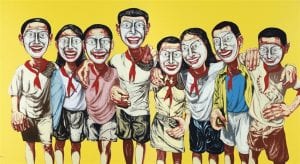Zeng Fanzhi, Mask Series No. 6, 1996. Oil on canvas, 199 x 179 cm.
Image Source: http://www.artnet.com/artists/zeng-fanzhi/mask-series-no-6-diptych-GFYqaQMg8IfqajjH5EihTQ2
During the latter part of the 20th century, Zeng Fanzhi became rather well known for his large oil paintings which challenged and pushed past the confines of Socialist Realism. Zeng considers many aspects in his paintings: dealing with issues of identity, existential questions and Western influence. Having become captivated by German Expressionism which was ‘born on a wave of resistance and reaction,’ Zeng adopted a similar technique as a means to expose common concerns (Discover Goldmark, 2017). Further, Zeng’s painterly approach and distinct color palette help animate his characters as he aims to evoke feelings of empathy. In Mask Series No. 6, Zeng portrays eight figures happily standing side by side. Each character appears young and healthy, wearing t-shirts and red neckerchiefs, with their arms wrapped around each other. By doing this, Zeng generates a jovial atmosphere which, in turn, contrasts well with his bleak critique on current societal issues. Every figure is depicted wearing a white mask that bears a big, gaudy smile, obscuring the face of the individual, ‘suggesting the uncertain identity of the individual, in a rapidly changing society’ (Andrews, 2012: p.265). Zeng’s Mask Series paintings are particularly good at revealing common mentalities amongst the Chinese population, as people were forced to deal with the harsh realities of the Cultural Revolution, which followed The Hundred Flowers Movement, leaving many untrusting and scarred. This hostile environment instilled fear amongst the population to express their opinions and criticisms, which is why Zeng handles each mask in the same manner; slightly smudged and tattered holding the same expression, unable to see what lies beneath. By masking the characters in his image, Zeng creates a distance between the subject and the viewer, ‘the bodily expressions of modern individuals rigidify into stock configurations, as if, like their items of couture, they were following standards of fashion. Each person becomes divided from a suitably personal, organic mode of being’ (Shiff, 2010: pp.13-14).
Further, Zeng places red neckerchiefs on each figure, which are symbolic of the youth movement of the Communist Party. Zeng juxtaposes the red neckerchiefs and white masks, the masks ‘bearing a strong resemblance to masks used in Chinese opera, and also referencing the ‘mask’ of Western dress and modernity,’ emphasizing culture influence, the merging of cultures and whitewashing (Shiff, 2010: p.15). Zeng utilizes scale as he produces these large paintings, enabling the audience to come face-to-face with his characters in a thought provoking manner.
Bibliography:
Andrews, Julia Frances., and Kuiyi Shen. The Art of Modern China. University of California Press, 2012.
“In Focus | A Brief History of German Expressionism.” Discover Goldmark, 11 Apr. 2017, discover.goldmarkart.com/brief-history-german-expressionism/.
Shiff, Richard. Zeng Fanzhi: Every Mark Its Mask. Hatje Cantz, November 30, 2010.



February 4, 2019 at 2:53 pm
It is interesting how you mention that the masking of the characters creates a sense of distance between the viewer and the painting. I personally analyzed distance in my painting as different levels of planes, but here a physical object is separating years of repression from the viewer. As you mention, the first initial glance at the painting leaves the impression that it is bright, colorful, and happy. However, further analysis engages the viewers as we want to learn the people’s expression and emotion underneath the masks. I appreciated your analysis of the masks and how their tattered, similarly handled state represented the fear to express one’s own opinions. This made me think about my own artist and how painterly style can be a powerful, yet purposeful tool. I think this analysis allowed me to delve deeper into the idea that the artist is purposely using certain techniques to emphasize the message of their painting. Specifically, how you analyzed individual elements of the painting and reasoned how they work together as a whole. This allowed me to see my artist’s work in a different perspective, specifically how everything is meticulously placed in a painting to evoke emotion amongst the viewer.
February 4, 2019 at 8:28 pm
It is interesting to see how Zeng Fanzhi and many artists of this generation have similar idea on expressing their artworks. Zhang Xiaogang like Zeng Fanzhi took his own personal experience during the cultural revolution and express it on his paintings. This concept of personal expression is a drastic departure from the socialist realism. The idea of a painting having a deeper meaning can be seen in Zhang Xiaogang’s works as well. The people in the mask series look like they are happy but once the viewers analyzed the painting further, you can see that the artist is criticizing the current situation of the society. This is similar to the bloodline series that i am researching on. At a glance you might it is a painting of a family photo but if you look at a deeper level you will see that the artist is talking about the effects of the cultural revolution and the lost of self-identity.